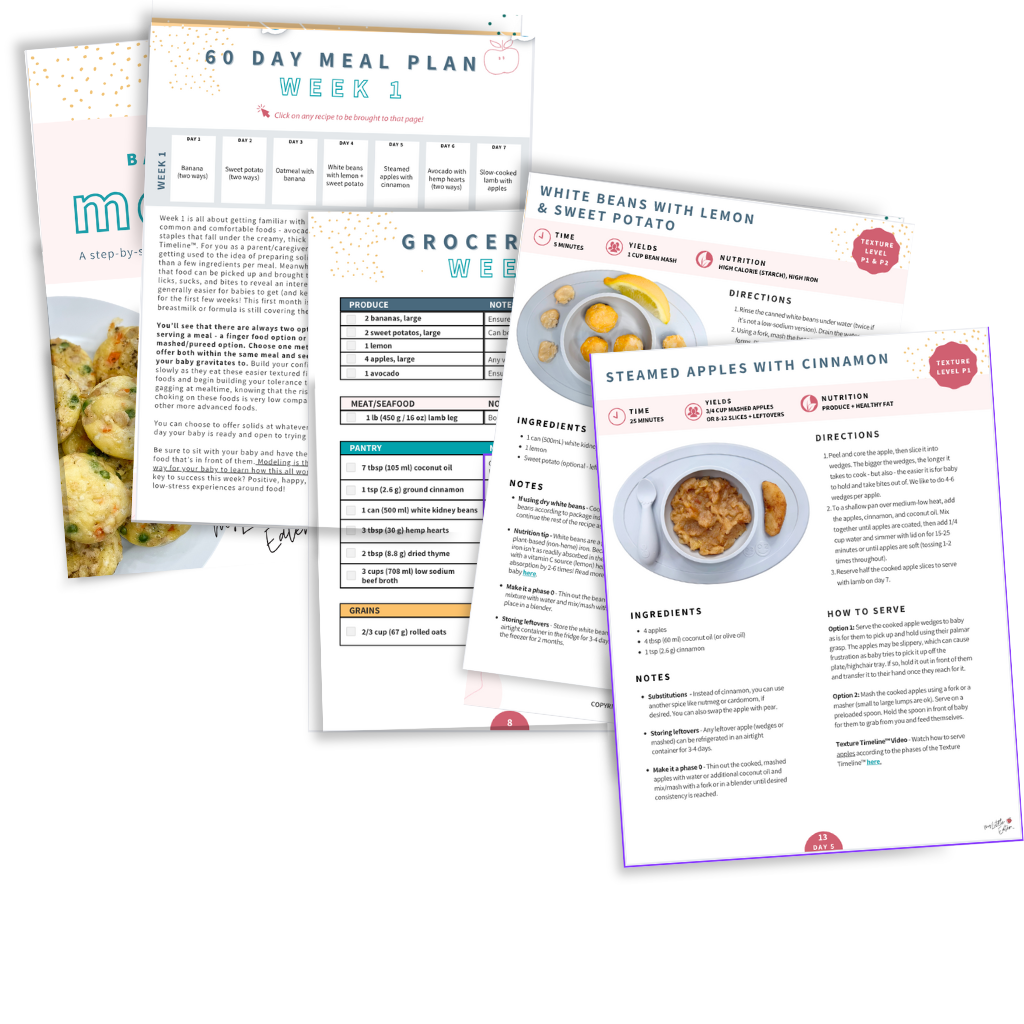![Main image for the article [Why a little hunger is NOT an emergency]. Pictured is a toddler holding a clock.](https://mylittleeater.com/wp-content/uploads/2019/08/New-Blog-Post-Image-Size-7-300x300.png)
I work with parents of picky toddlers all the time. I work with parents of toddlers who aren’t sure how to cope with common mealtime scenarios and manage feeding their toddlers. And it’s HARD to know where to start with what seems like a myriad of issues. Today, I’m bringing up a topic (hunger and feeding on demand) that is the root cause of many parents’ concerns with mealtime behaviour (unbeknownst to them). It’s also a topic that has been the cause of much controversy over how to teach children to have a healthy relationship with food. So let’s start with the original scenario for how this topic of hunger and toddler behaviour came up.
It usually starts with parents (maybe like you!) who are frustrated with their toddler not eating anything at meal times. It may be becoming a regular battle at the dinner table to get your child to just try and eat something, ANYTHING off his/her plate. Perhaps you call them to the table, but they declare “I’m not hungry” and don’t want to eat. Or maybe they do eat a couple bites here and there, but hardly enough to consider it a meals worth.
I totally get it. I get how frustrating it can be to work hard to prepare a dinner for your family, only to receive pushback and uninterested stares at what you’ve set in front of them. Now before I automatically jump to the conclusion that you have a picky eater (which you may, but hear me out), did you know that the number 1 reason most kids just aren’t eating their food at mealtimes is because they’re actually just not hungry?
And did you know that the number 1 reason why they are not hungry is because they are likely just snacking too much throughout the day?
The snacking or “grazing” phenomenon we have created especially within this past two generations is quickly becoming out of control. In a 2010 study, it was shown that kids are snacking an average of 3 times a day in comparison to an average of once a day just a few decades ago, and the biggest increase is shown in kids aged between 2 and 6 years old. Why is this such a big problem?
For one, more snacking = more overall calories consumed (research shows up to 586 extra calories per day in fact!) So it’s no wonder that kids aren’t hungry at mealtimes! And it’s no wonder kids are more prone to obesity in this generation over all others. Not to mention that having constant snacks around means it’s more likely they’ll have to be packaged (usually meaning less healthy), since snacking is expected to happen so frequently throughout the day.
Secondly, when children are constantly grazing on snacks all day (even when they are healthy snacks), they fail to develop the proper hunger cues that tell their bodies when they need to eat and when they are full and satisfied. When kids are being constantly fed little bits over the course of a day, their stomachs are never entirely empty, and so they really have little experience knowing what it’s like to be truly hungry! A healthy child should be able to recognize the symptoms telling him/her they need to eat, and have developed proper self-regulation to know when to stop eating. If they approach the dinner table without any of these cues, they don’t feel the least bit compelled to eat what’s in front of them. This may lead them to play with their food instead of taste it, scowl and turn away, or immediately want to be let down from the table. Parents may then look at this at think that they have a picky eater on their hands when really it’s just that they really don’t feel the urge to eat.
In this way, snacking on demand or grazing is one good way to undo the innate appetite regulation skills babies and toddlers have engrained in them from birth. It actually promotes more mindless vs. mindful eating. If your toddler sees that a highly palatable snack is available anytime they ask for it, they will turn to that snack in much the same way we adults turn to mindless snacking when ignoring our fullness cues. They will learn to eat it because it’s there, because it’s habit they eat in front of the TV, because it’s highly palatable, or because they can’t decipher their feelings of tiredness, sadness, crankiness etc. and turn to food as a form of comfort. In fact, toddlers don’t always know what it means to be hungry or be full. When we ask them, they try their best to associate the feeling they have in their stomach with the words they know in their vocabulary, but they’re going to get them wrong most times. And so, immediately responding to the words “I’m hungry” as if it means true hunger from a toddler is actually acting prematurely and with feelings rather than good sense. Note: there are lots ways to teach hunger and fullness to toddlers and kids, but we’ll leave that for another blog post.
Finally, when kids know that they will receive a snack on demand, they will often choose to forgo a meal (even if they are hungry) and hold out for the snack that they know is coming very soon after. Many times kids use the excuse that they’re full and don’t want to eat anymore, only to ask for a snack just minutes later! This is because they know that there will always be a snack on demand and would rather just wait until then so that they get another (likely yummier) food option. Smart kids! Not conniving…but just doing what they’ve been taught they can do. And here also begins the power struggle between parents and toddlers, when they are able to snack (or eat meals) on demand.
So what can parents do?
The absolute best thing that parents can do is allow their kids to feel what hunger really means (within reason) by maintaining a general feeding schedule! For all the reasons mentioned above, but particularly for mindfulness. Toddlerhood is a time for learning how to consciously tell the difference between being hungry for example, and being angry or tired or needing a hug. It’s our job to help them with this (and it’s an important one), and though it may take some trial and error to learn all their signs and signals and teach them how to recognize them as well, it will be much easier for you to not feed for emotional reasons if you stick to scheduled meals and snack times.
What do I mean by feeding for emotional reasons? Well – often times us parents fear hunger…like…we’re terrified if our toddler even so much as hints they could be hungry. There is NO way we can not act. We leave the house with a bag stashed with snacks out of fear that you won’t have anything to give them the immediate moment they ask for one. I get it – part of it is wanting to protect them from any discomfort or harm. But know this, even if it REALLY is true hunger and not confusion with being bored etc. – hunger is NOT an emergency. In fact, we need to start seeing the good side of a little hunger. We’re not talking starvation (FYI they can’t starve in two hours). We’re talking about allowing their stomach to empty and build up a true appetite for the next meal. To digest. To rest. That’s a great thing. That’s how we’re evolved to be. And when they rest and digest, they learn what FULL means once food is around. They begin to understand…oh… I need to eat to this point (full) so that I last until next meal or snack time. This is called appetite regulation.
And remember that with scheduled meals and snacks, there is always another eating opportunity coming around. That’s the beauty of a feeding schedule – toddlers and older kids learn to build trust and security in their parents that food will always be offered at regular intervals, and when it’s timed out well, food will be offered before they ever get to a point of uncontrollable hunger. In fact, there won’t ever be a need to even ask for snacks in the situation that they are truly hungry – you’re already ahead of it! They know it, you know it – and everyone can relax!
Even so, sometimes, as parents we get so stressed out about the thought that our child might have to wait half an hour or an hour to eat, that even if they feel a touch of true hunger, we often sooner are willing to offer them some chips or candy rather than wait half hour for a healthy nourishing snack/meal, just to avoid this ultra feared feeling of a bit of hunger. Let’s not pass on this fear to our kids that we often battle with ourselves. Let’s show them that it’s ok to have a little hunger…to not feel completely full at all times…to be patient, to control our blood sugar levels by eating balanced meals at regular intervals and to wait rather than rush to eat anything in sight, because the next eating opportunity is just around the corner.
So let’s talk about what this structure or schedule could look like. Within the context of meals and snacks, part of this structure means having scheduled and consistent snack times each day in between meals. It doesn’t mean it can’t be a bit flexible day to day…but it does need to be there. Because toddlers’ stomachs are small, they typically need to eat every 2-3 hours to keep themselves full. Therefore it makes sense to have a snack in between each meal and before bedtime (about 6 small meals per day). School aged children have the capacity to eat and fill their bellies more at meal times, so they really only need to eat every 3-4 hours (e.g. breakfast at 7:30 am, lunch at 11:30 pm, snack at 3:30, dinner at 6:30 pm). Unless bedtime is more than 2 or 3 hours past dinner time, there really is no need for a bedtime snack to be offered. So outside of the scheduled meal or snack times, it’s crucial to let your kids know that snacks won’t be given out! This means… if your child refuses a meal (or snack) or just doesn’t eat enough, they can wait until the next feeding time to eat again. Keep in mind also that drinking too much milk throughout the day also can contribute to feeling too full. While it’s nutritious, toddlers over 12 months of age should have no more than around 2 cups of milk each day. I find it’s best to offer water in between meals and they give try giving 1/2 cup or so at mealtimes (or just after) to prevent them from filling up too much before they’ve been given the chance to eat.
By not allowing your child to graze or eat on demand – it’s not cruel or a form of punishment – it’s just making it possible for your toddler to be successful with eating. You want them to come to the table hungry but not famished. You want them to learn to know how much to eat to fill them up… what it truly means to eat enough in one sitting to be satisfied. Much like making sure they get enough sleep, it’s your job to help them learn to regulate their appetite.
So yes…YOU need to get ahead of the game a little and be ready to offer food regularly. Anticipate the need for a snack or meal at these general times and offer it regardless of whether they say they are hungry or full. We need to get ahead of and not wait until a meltdown to start thinking about snacks and meals. And to be clear here, there is NO forcing them to eat – only teaching them that food will regularly come around at routine times and that in between these feeding times, we do other things.
While it may seem easier to avoid any potential temper tantrums and just give in with a snack when they ask for it, it really isn’t worth it. It only takes a day or two to establish a new routine with your child, and as long as you are firm and consistent, they will quickly understand and adjust to the new schedule.
Part 2 of this post will talk all about how to put feeding schedules into practice! I’ll give you tips and downloadable freebies to help make this easier for you AND to help your toddler understand and willingly comply with little resistance because it’s habit and it makes sense to them.
With a little provision around the timing of snacks and meals, the chances that you will be battling less at the dinner table all of a sudden becomes much higher. Not to mention, you will be helping your child develop mindful eating habits that will serve them well throughout their life.
Happy feeding!





